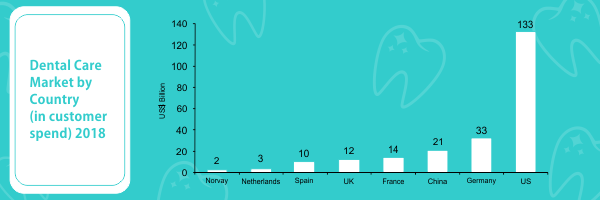
How dental innovation fund can be beneficial for the dental industry
Dental investments can offer greater ROI to the investors while reshaping our idea of oral care solutions.

It is very common for dentists to invest hard-earned money outside their profession. To be sure, dentistry is one of the most profitable businesses in the United States, and institutional funds are flowing in at an unprecedented rate. It is also true that when dentists reinvest in dentistry, they get a large rate of return on their investment.
So why are so many dentists today investing in a variety of non-dental investments such as single-family homes, digital currencies, public companies, private stocks, non-dental companies, and investment trusts? We believe that the answer is not related to ROI, but to the lack of expertise in various investments that are readily available and directly related to the field of dentistry.
The dental industry is expected to remain an investor focus for the next few years, and dental chains need to focus on achieving sustainable organic growth. An important approach to achieving this is to focus on added value by developing patient pathways that leverage key technological advances to enhance patient collaboration beyond the dentist-patient relationship.
The Dental Innovation funds support the development of digital technology born of the Faculty of Dentistry. It is designed to allow educators, residents, and students to incorporate ideas from laboratory or clinical concepts into proof of principles. This program funds projects with potential commercialization and is not another source of research funding.
Dental spending in the US is expected to increase by 5% this year from 3.7% last year. What do you say when the growth rate goes up? - Its exponential growth and a great investment opportunity.
So what's behind the current innovative dental care? We have identified the following 3 major trends:
- First is the aging of the population of the USA. It is a well-known fact that we are all old and that older people need more innovative dental care. This is built into the growing demand for the foreseeable future.
- Second, there will be a rise of self-culture that drives younger adults to choose aesthetic dentistry such as tooth whitening, orthodontics, and restorative dentistry. Social media may have been thought to be fashionable, but in the last decade, social media has become a rooted part of our culture and there is no reason to think of it as ubiquitous.
- Finally, the growth of overseas markets has great potential for these Dental DSO companies. As people around the world see an improved standard of living, the standard of oral health and beauty increases.
How Dental care market evolved in the US?
In the Western dental market, economic prosperity, population growth, and aging, as well as growing interest in oral health and improved insurance coverage (especially in the United States), have led to modest but steady total dental spending. It is an important factor behind the growing popularity of Dental investments. The US market is currently worth an estimated USD 133 billion and is projected to grow 3% annually through 2023. Most European markets are expected to grow at a similar rate of about 24%.
In addition to the dynamics of demand, the attractiveness of a country or region is also determined by the structure and stability of the healthcare system. From an investor's perspective, stable or predictable health and regulation are important considerations for potential future value.

Attractive fundamentals in the highly fragmented dental market have led to ongoing M & A activities in Europe and the United States. The traditional operational benefits of creating a chain of dentists remain and can be important for dental investors, dentists, and patients. Large chain dentists can provide economies of scale, efficiency, and risk management improvements. This cannot be handled by the standalone method. Back-office functions can be centralized and operated from a single location shared service center, and lab work can be outsourced.
This integration enables the economics of large-scale investments in state-of-the-art technology and equipment, while at the same time being equipped to meet increasing regulatory measures.
Moreover, chain dentists offer patients a wide range of dental and orthodontic services under one roof, making it easy for them to maintain their oral health. The industry structure in most regions remains attractive for M & A activities. As many dentists approach retirement age, there is a shortage of highly skilled professionals, the workforce is becoming more and more part-time, and it is difficult for dentists to find a replacement.
Private equity investors have dominated acquisitions in the US and European dental markets. Approximately 80% of these transactions involved private equity as investors, sellers, or both. The United States has completed at least 68 acquisitions since 2017, and almost all of these transactions involve private equity.
How are the DSO companies in the US planning for the future of the dental market?
By acquiring the right investments in dentistry while building strategies and realizing operational benefits are the most commonly implemented strategies to bring in value to the field. In addition to focusing on procurement and labor cost optimization, it mainly explains the focus of DSO's current value play. However, in the future, long-term value creation strategies will need to focus on patient involvement to realize the full potential in an increasingly competitive market.
Why are DSOs quite hopeful about dental investment returns?
The DSOs are quite positive about the outcomes in the investment in dentistry because they have a step-by-step approach towards modernizing the sector in different phases.
Multi-arbitrage is still a lever of great value as it can take smaller practices from the chain at relatively low multiples and sell at higher multiples including size premiums. However, as various (financial) stakeholders pay more attention to the dental industry, multipliers are increasing in both small and large-scale practice. Partly because of this increase, past results have been mixed, making parties more critical and no longer seeing all available practice as a potential target, but instead on some aspects such as patient-based size. Evaluated medical care based on. And the long-term relationship between currently employed dentists and those dentists, the ability to integrate into existing practice, etc.
As it becomes increasingly difficult in most regions to achieve exit returns that result directly from multiple arbitrage transactions, it is becoming increasingly important to realize operational benefits in the value creation process. An important part of these operational benefits comes from the insourcing of laboratory or engineering work. While there is still plenty of potential for integration in dental laboratories, technological advances (e.g., in-house 3D flour milling, printing, and automation technologies) can have a significant impact on the current industry and therefore dentistry. It can have a significant impact on the future as a significant part of the laboratory. Some parts of the industry can replace the current craftsmanship that looks dark.
In the future, we advocate a gradual transition from a dentist-patient relationship to an office-patient relationship, but the dentist-patient relationship remains critical to today's patient involvement. Therefore, in the short to medium term, the DSO should focus on being the employer of choice for dentists and other key workers. In addition, operational efficiency can be achieved, for example, by preventative-oriented KPI control, improved resource planning, and redistribution of tasks between dentists and hygienists.
Given the dynamics of the current market, the success of integrated games requires a focus on the sustainable and long-term value that can be achieved by improving the revenue and quality of revenue of DSOs. Given the importance of healthcare and trust in patient-centricity, which are essential to patient retention, sustainable and long-term value requires strategic choices regarding business models. Patient retention is an important way to increase patient-based value. Patients usually leave the clinic when they move to another location or when the dentist leaves the clinic. This allows you to fully cover the clinic as well as the dentist and gain more involvement.

DSO should aim to engage with patients and build trust at the organizational level, rather than relying solely on the individual dentist-patient relationship. Therefore, patients need to experience a sense of connection and trust in their interactions with the DSO. Customized dental patient pathways tailored to the needs of DSO's specific target demographics should enable this transition to a strengthened trust-based relationship. We believe that regular interactions that combine transparency and quality of service are the most important means of achieving this. By digitizing patient care pathways, this technology may also be vital to supporting patient participation in DSO.
The dental DSO companies in the US are increasingly using innovative digital solutions and software to build sustainable relationships with their patients.
How dental investment funds and digital dentistry are bringing in more prospects into the field?
Traditionally, the dentist's main focus has been regular care and healing in the dental office. Although it varies from country to country, dental treatment was primarily related to healing and not so much to prevention.
Enhancing the in-practice dental care:
Driven by changing payer and customer preferences, the focus has recently shifted to preventative and aesthetic treatments. Most DSOs have quickly embraced growing interest in prevention for the benefit of patients and DSOs.

This improves overall oral health, reduces the risk of secondary health problems, and reduces the need for fillings, root canals, and other emergency dental treatments, resulting in long-term savings. DSO has the advantage of frequent visits and high profitability because (preventive) assistants and dental hygienists can provide preventive treatment, allowing dentists to focus on complex and quality treatment. DSOs can also make conscious strategic decisions regarding their treatment composition. For example, technological advances are increasing access to orthodontics with the introduction of clear aligners based on the growth of multiple players in the United States.
The combination of these digital oral care solutions and the professionals who carry them out offers opportunities for optimization and can be leveraged of significant value.
Technological advances have enabled DSOs to make optimal use of chair time and patient planning, but they can also improve patient care and involvement. The use of intraoral scanners by dentists provides better insights into the patient's oral health by allowing for more complete, accurate, and high-resolution monitoring. The shorter scan duration helps dentists detect dental disorders early and implement preventative treatment plans. You can use the relevant software to create a visualization of the patient's teeth, but you can also simulate the outcome of the treatment. Visualization improves case acceptance, increases patient involvement, and ultimately improves patient oral health.
Better appointment planning and office visits:
Providing innovative methods for engaging patients before and after consultation in terms of appointment scheduling and reminders, online visibility and referrals, payment solutions, and automated communication can differentiate DSO from the competition. Technology solutions can play a key role in streamlining patient relationships and marketing processes.

Appointment scheduling and reminder software solutions can automate front office functions to improve patient experience, office utilization, and efficiency. Appointment reminders can be automated to change individual patient names, dates, and times, and can take the form of customizable text messages, recorded phone calls, and email notifications. Advanced schedule and reminder tools allow patients to confirm, reschedule, or cancel appointments, and the dentist's schedule is linked to the software package. Treatment plans can be automatically shared between the dentist, the receptionist, and the patient. Ultimately, these tools not only allow for more frequent communication with patients but also benefit dental practice by limiting the number of no-shows and "empty slots" throughout the day.
Offering dental care at home:
Good oral health is most often the result of the patient's discipline in their daily oral care. Although the dentist makes direct contact with the patient only 12 times a year, it can play an important (indirect) role in the patient's daily life. Currently, contact between the patient and the DSO outside the dental office is limited, but again, technological developments enable innovative ways of patient involvement. The most profound examples in the market for improving the influence of dentists in absent care are remote dentistry (e.g. online consultation) and smart devices (e.g. connected toothbrushes). Remote dentistry or Tele-dentistry and smart devices can also be combined to monitor the health of the patient's oral cavity and create new insights that benefit patients, dentists, and payers.

Remote dentistry allows dentists to stay in touch with patients outside the office, improving access to dental care for people living in remote areas and those with low mobility. Remote dentistry can be accessed via a computer or smartphone and ideally linked to clinical management software and patient records for online consultation and training (e.g., sharing detailed brushing schedules to optimize treatment outcomes). DSO can leverage remote dental applications to track treatment plans and respond to ad hoc demands. Remote dental services potentially provide an additional source of income and do not necessarily have to be performed by a dentist.
In addition, electric toothbrushes can be turned into smart devices that can provide dentists, patients, and insurance companies with insights into their patient's brushing routines. When accessing the dentist, this information can be used to control and monitor brushing behavior (via remote dentistry). The dentist can also get a more comprehensive picture of the oral health of the patient when he or she visits the office. There are currently several smart toothbrushes on the market that can remotely monitor brushing activity and oral health.
To attract and retain patients, some DSOs distinguish themselves by offering a fixed number of treatments and an innovative payment model that is based on a subscription. The payment model is an overlooked step in the customer experience that can be effectively used to strengthen patient relationships. A new and innovative subscription-based model for the dental industry includes cloud-based software that enables DSOs to design and manage membership plans by defining pricing and discounts.
Conclusion: Will the Dental industry get better with proper investments?
DSOs and investors will need to look for organic value creation options for sustained organic growth in the US dental industry in the coming years. Multiple arbitrages are likely to deliver lower returns than five years ago.
In dentistry, trust is largely based on the patient and the provider. To create sustainable value, patients need to trust the organization, since this is the critical element of any healthcare business. DSOs can create lasting value by extending trust beyond patient-dentist relationships and incorporating broader elements into their business practices.
In the future, DSOs that can permeate the entire tissue with a culture of lifelong patient involvement and put it at the center of the core as part of DNA have the potential to succeed. DSOs need to clearly define their strategic vision and ambitions to achieve long-term sustainable growth.
As you can see, you don't have to look out for dentistry for the best benefit of your finances. So, dive deeper into these topics and enjoy the rewards of dentistry investments - one of the most rewarding fields of our time.
To learn more about the Dental Innovation Fund, reach out to us at contact@dentalinnovation.fundor visit our website https://dentalinnovation.fund/